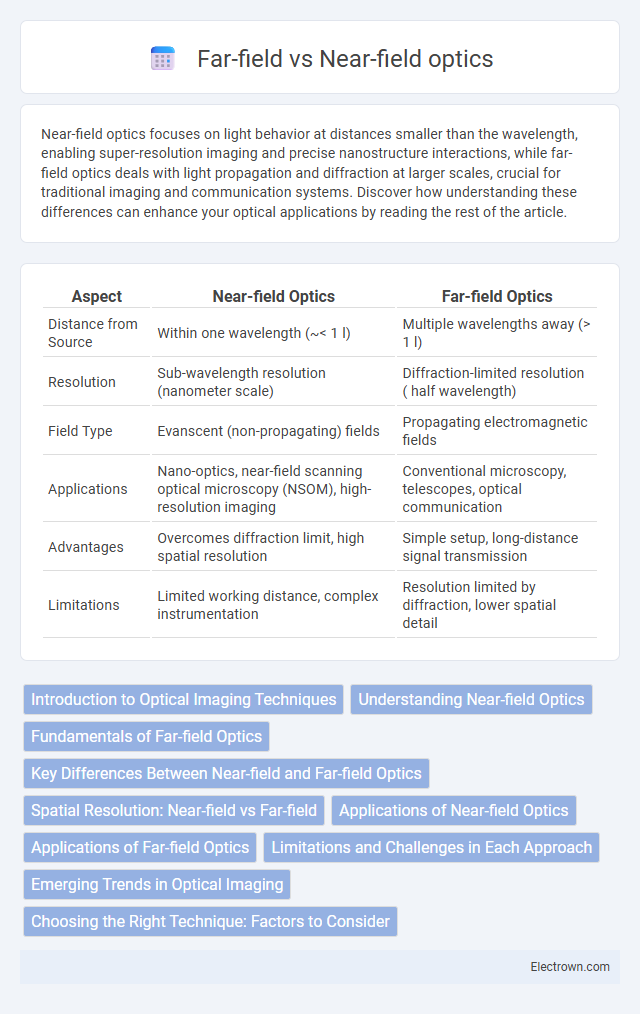Near-field optics focuses on light behavior at distances smaller than the wavelength, enabling super-resolution imaging and precise nanostructure interactions, while far-field optics deals with light propagation and diffraction at larger scales, crucial for traditional imaging and communication systems. Discover how understanding these differences can enhance your optical applications by reading the rest of the article.
Table of Comparison
| Aspect | Near-field Optics | Far-field Optics |
|---|---|---|
| Distance from Source | Within one wavelength (~< 1 l) | Multiple wavelengths away (> 1 l) |
| Resolution | Sub-wavelength resolution (nanometer scale) | Diffraction-limited resolution ( half wavelength) |
| Field Type | Evanscent (non-propagating) fields | Propagating electromagnetic fields |
| Applications | Nano-optics, near-field scanning optical microscopy (NSOM), high-resolution imaging | Conventional microscopy, telescopes, optical communication |
| Advantages | Overcomes diffraction limit, high spatial resolution | Simple setup, long-distance signal transmission |
| Limitations | Limited working distance, complex instrumentation | Resolution limited by diffraction, lower spatial detail |
Introduction to Optical Imaging Techniques
Near-field optics enables imaging beyond the diffraction limit by capturing evanescent waves close to the sample surface, offering high-resolution detail at the nanoscale. Far-field optics relies on propagating light waves and conventional lenses to form images, typically limited by diffraction to around half the wavelength of light. Your choice of optical imaging technique depends on the resolution requirements and the scale of features you aim to visualize.
Understanding Near-field Optics
Near-field optics involves the interaction of light with objects at distances smaller than the wavelength of light, enabling resolution beyond the diffraction limit. Techniques such as near-field scanning optical microscopy (NSOM) exploit evanescent waves to achieve nanoscale imaging and manipulation. This contrasts with far-field optics, where light propagates freely and resolution is limited by diffraction, typically around half the wavelength of light used.
Fundamentals of Far-field Optics
Far-field optics studies light behavior at distances much greater than the wavelength, where wavefronts can be approximated as planar. The fundamental principle involves the Fraunhofer diffraction regime, enabling analysis of angular spectra and spatial frequencies with simplified mathematical models. Understanding these concepts allows you to design optical systems that efficiently manipulate light for imaging, sensing, and communication applications.
Key Differences Between Near-field and Far-field Optics
Near-field optics operates at distances smaller than the wavelength of light, enabling spatial resolution beyond the diffraction limit by exploiting evanescent waves, while far-field optics deals with light propagation at distances much larger than the wavelength, governed by diffraction and interference patterns. Near-field techniques, such as near-field scanning optical microscopy (NSOM), achieve nanoscale imaging by detecting non-propagating fields close to the sample surface, contrasting with far-field methods that rely on lens-based imaging systems limited by diffraction. The primary difference lies in the spatial resolution capabilities and the behavior of electromagnetic fields, with near-field optics providing sub-wavelength detail inaccessible to far-field techniques.
Spatial Resolution: Near-field vs Far-field
Near-field optics achieves spatial resolution beyond the diffraction limit by detecting evanescent waves within a few nanometers of the sample surface, enabling imaging at scales down to tens of nanometers. Far-field optics is constrained by the diffraction limit, typically around half the wavelength of light used, resulting in spatial resolution on the order of hundreds of nanometers. Your ability to discern fine structural details improves significantly with near-field techniques, especially in applications requiring nanoscale imaging.
Applications of Near-field Optics
Near-field optics enables super-resolution imaging and nanolithography by exploiting evanescent waves that exist within a distance smaller than the wavelength of light, allowing detailed examination and manipulation of structures at the nanoscale. This technology is crucial for applications in biological imaging, where it reveals cellular and molecular details beyond the diffraction limit, and in data storage devices to achieve high-density recording. Your ability to utilize near-field optics can significantly improve precision in fields requiring nanoscale resolution and fine structural analysis.
Applications of Far-field Optics
Far-field optics plays a crucial role in applications such as telescopic imaging, where distant objects are observed with high resolution using lenses and mirrors designed to handle light propagation over large distances. It is essential in optical communication systems, enabling the transmission and reception of light signals across vast optical fibers or free-space links. Furthermore, far-field techniques facilitate laser beam shaping and optical data storage technologies, relying on precise control of light patterns at significant distances from the source.
Limitations and Challenges in Each Approach
Near-field optics faces limitations in spatial range due to evanescent wave decay, restricting effective imaging to distances within a fraction of the wavelength, which complicates practical applications for larger scales. Far-field optics struggles with diffraction limits, causing resolution constraints typically around half the wavelength of light, posing challenges for nanoscale imaging and precision. Both approaches encounter trade-offs between resolution and operational distance, necessitating advanced techniques like super-resolution microscopy or antenna designs to overcome physical barriers.
Emerging Trends in Optical Imaging
Emerging trends in optical imaging highlight the growing importance of near-field optics for achieving nanoscale resolution beyond the diffraction limit, enabling detailed visualization of subcellular structures and materials. Far-field optics continues to advance with techniques such as super-resolution microscopy, which enhance imaging depth and speed for biomedical and industrial applications. Integrating near-field and far-field methods fosters hybrid imaging systems that leverage the strengths of both regimes for comprehensive analysis at micro- and nanoscale levels.
Choosing the Right Technique: Factors to Consider
Choosing between near-field and far-field optics depends on resolution requirements, working distance, and application context. Near-field optics enables nanoscale imaging beyond the diffraction limit by placing the probe within a few nanometers of the sample surface, ideal for high-resolution microscopy and nanofabrication. Far-field optics suits scenarios demanding larger working distances and broader fields of view, such as conventional microscopy and optical communication, emphasizing wavelength and numerical aperture as key parameters.
Near-field vs Far-field optics Infographic

 electrown.com
electrown.com